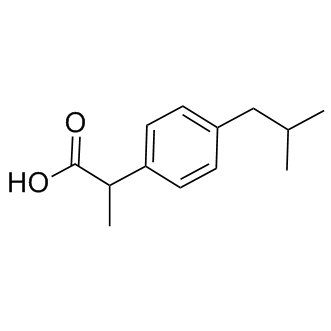
Ibuprofen
CAS No. 15687-27-1
Ibuprofen( ±)-Ibuprofen )
Catalog No. M12241 CAS No. 15687-27-1
A non-selective, reversible COX inhibitor with IC50 of 1 ug/mL and 46 ug/mL for COX-1 and COX-2 in enzyme assay, respectively.
Purity : >98% (HPLC)
 COA
COA
 Datasheet
Datasheet
 HNMR
HNMR
 HPLC
HPLC
 MSDS
MSDS
 Handing Instructions
Handing Instructions
| Size | Price / USD | Stock | Quantity |
| 500MG | 41 | In Stock |


|
| 1G | 48 | In Stock |


|
Biological Information
-
Product NameIbuprofen
-
NoteResearch use only, not for human use.
-
Brief DescriptionA non-selective, reversible COX inhibitor with IC50 of 1 ug/mL and 46 ug/mL for COX-1 and COX-2 in enzyme assay, respectively.
-
DescriptionA non-selective, reversible COX inhibitor with IC50 of 1 ug/mL and 46 ug/mL for COX-1 and COX-2 in enzyme assay, respectively; converts arachidonic acid to prostaglandin H2 (PGH2); is used for treating pain, fever, and inflammation.Pain Approved(In Vitro):Ibuprofen (24 h) inhibits COX-1 and COX-2 activity with IC50 values of 13 μM and 370 μM.Ibuprofen (500 μM, 48 h) inhibits cell proliferation and angiogenesis, and induces apoptosis in AGS cells (Adenocarcinoma gastric cell line).Ibuprofen (500 μM, 48 h) downregulates transcription of Akt, VEGF-A, PCNA, Bcl2, OCT3/4 and CD44 genes, but upregulates RNA levels of wild type P53 and Bax genes in AGS cell.Ibuprofen (500 μM, 24 h) restores microtubule reformation, microtubule-dependent intracellular cholesterol transport, and induces extension of microtubules to the cell periphery in both cystic fibrosis (CF) cell models and primary CF nasal epithelial cells.Ibuprofen (500 μM, 24 h) enhances UV-induced cell death in MCF-7 cells and MDA-MB-231 cells by a photosensitization process.(In Vivo):Ibuprofen (300 mg/kg; p.o.; daily, for 14 days) reduces overall tumor growth and enhances anti-tumor immune characteristics without adverse autoimmune reactions in a model of postpartum breast cancer.Ibuprofen (60 mg/kg; i.h.; every second day for 15 days) reduces the risk of neuropathy in a rat model of chronic Oxaliplatin?induced peripheral neuropathy.Ibuprofen (20 mg/kg; p.o.; every 12 hours, 5 doses total) decreases muscle growth (average muscle fiber cross-sectional area) without affecting regulation of supraspinatus tendon adaptions to exercise.Ibuprofen (35 mg/kg; p.o.; twice daily) attenuates the Inflammatory response to pseudomonas aeruginosa in a rat model of chronic pulmonary infection.
-
In VitroIbuprofen (24 h) inhibits COX-1 and COX-2 activity with IC50 values of 13 μM and 370 μM.?Ibuprofen (500 μM, 48 h) inhibits cell proliferation and angiogenesis, and induces apoptosis in AGS cells (Adenocarcinoma gastric cell line).?Ibuprofen (500 μM, 48 h) downregulates transcription of Akt, VEGF-A, PCNA, Bcl2, OCT3/4 and CD44 genes, but upregulates RNA levels of wild type P53 and Bax genes in AGS cell.?Ibuprofen (500 μM, 24 h) restores microtubule reformation, microtubule-dependent intracellular cholesterol transport, and induces extension of microtubules to the cell periphery in both cystic fibrosis (CF) cell models and primary CF nasal epithelial cells.Ibuprofen (500 μM, 24 h) enhances UV-induced cell death in MCF-7 cells and MDA-MB-231 cells by a photosensitization process.Cell Viability AssayCell Line:AGS cells Concentration:100-1000 μM Incubation Time:24 h, 48 h Result:Inhibited AGS cell viability with IC50 values of 630 μM (trypan blue staining, 24 h), 456 μM (neutral red assay, 24 h), 549 μM (trypan blue staining, 48 h) and 408 μM (neutral red assay, 48 h).
-
In VivoIbuprofen (300 mg/kg; p.o.; daily, for 14 days) reduces overall tumor growth and enhances anti-tumor immune characteristics without adverse autoimmune reactions in a model of postpartum breast cancer.Ibuprofen (60 mg/kg; i.h.; every second day for 15 days) reduces the risk of neuropathy in a rat model of chronic Oxaliplatin induced peripheral neuropathy.Ibuprofen (20 mg/kg; p.o.; every 12 hours, 5 doses total) decreases muscle growth (average muscle fiber cross-sectional area) without affecting regulation of supraspinatus tendon adaptions to exercise.Ibuprofen (35 mg/kg; p.o.; twice daily) attenuates the Inflammatory response to pseudomonas aeruginosa in a rat model of chronic pulmonary infection. Animal Model:Syngeneic (D2A1) orthotopic Balb/c mouse model of PPBC (postpartum)Dosage:300 mg/kg, daily for 14 days Administration:Fed in animal feedings (added to pulverized standard chow and mixed dry, then mixed with water, made into chow pellets and dried thoroughly) Result:Suppresed tumor growth, reduced presence of immature monocytes and increased numbers of T cells.Enhanced Th1 associated cytokines as well as promotedtumor border accumulation of T cells.Animal Model: Oxaliplatin?induced peripheral neuropathy Dosage:60 mg/kg, every second day for 15 days Administration:Subcutaneous injection Result:Lowered sensory nerve conduction velocity (SNCV).
-
Synonyms±)-Ibuprofen
-
PathwayChromatin/Epigenetic
-
TargetCOX
-
RecptorCOX-1|COX-2
-
Research AreaNeurological Disease
-
IndicationPain
Chemical Information
-
CAS Number15687-27-1
-
Formula Weight206.2808
-
Molecular FormulaC13H18O2
-
Purity>98% (HPLC)
-
Solubility10 mM in DMSO
-
SMILESCC(C1=CC=C(CC(C)C)C=C1)C(O)=O
-
Chemical NameBenzeneacetic acid, α-methyl-4-(2-methylpropyl)-
Shipping & Storage Information
-
Storage(-20℃)
-
ShippingWith Ice Pack
-
Stability≥ 2 years
Reference
1. Mitchell JA, et al. Proc Natl Acad Sci U S A. 1993 Dec 15;90(24):11693-7.
molnova catalog



related products
-
COX-2-IN-1
COX-2-IN-1 is a potent and selective COX-2 inhibitor (IC50: 3.9 μM).
-
Benoxaprofen
Benoxaprofen is a non-steroidal anti-inflammatory drug.
-
Pelubiprofen
Pelubiprofen is an orally active, non-steroidal anti-inflammatory agent, a selective cyclooxygenase-2 (COX-2) inhibitor, which effectively reduces PGE(2) production by inhibiting COX activity.



 Cart
Cart
 sales@molnova.com
sales@molnova.com


